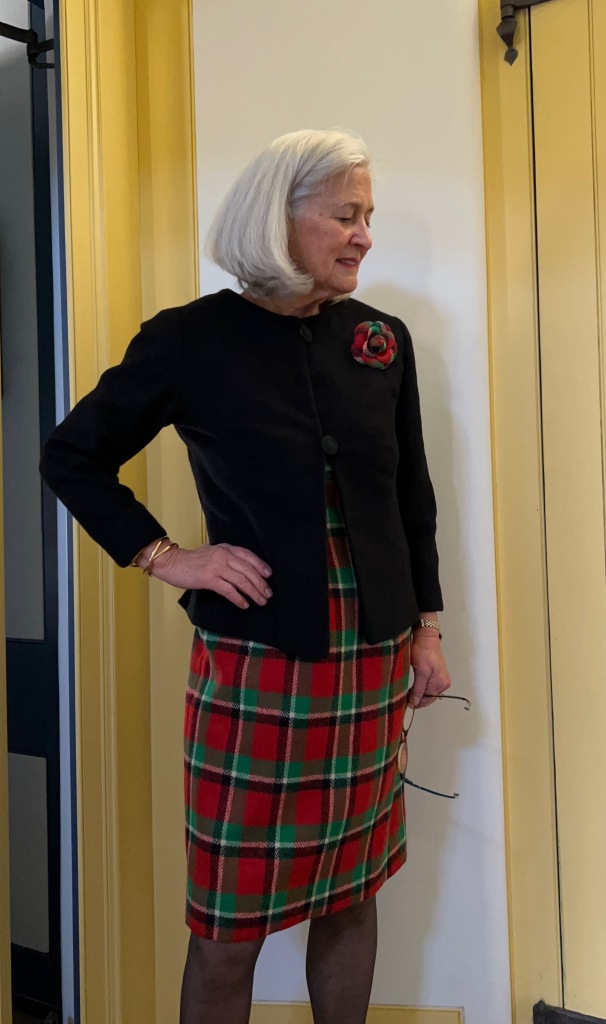It has been a slow start to the new sewing year of 2023. Although I had anticipated the completion of my first project – this black jacket – to be a speedy endeavor, I anticipated incorrectly! (Has anyone ever said fashion sewing can be very humbling?)
I was making this jacket to go specifically with a wool sheath dress I made two years ago – and also, hopefully, to pair with other dresses or skirts which might benefit from the addition of a somewhat dressy black jacket. I had the pattern, and I had the fabric, a very soft light-weight cashmere (which I found a number of months ago at Farmhouse Fabrics.)

I first needed to make a fitting muslin (toile) and I needed to determine what changes I would make to the original pattern. That ended up being three items:
- I changed the neckline to match the neckline of the sheath dress.
- I added a dart to the top of each sleeve, using that method as a substitute for the running stitches normally used to facilitate the insertion of the sleeve into the armscye. I have used this alteration frequently as it seems to fit my shoulder anatomy well.
- I shortened the sleeves from full-length to 7/8 length. I did this as I enjoy wearing bracelets, thus giving them a little “breathing room.”
Before I started making this jacket, I had the perception I would need to tie the sheath dress and the black jacket together in some way. Without a shared element, I wasn’t so sure they would necessarily look like they were made for each other. The only problem was, I had very little yardage remaining from the sheath dress, as I had made it from a limited piece of vintage wool. What to do?
Covered buttons would limit my ability to wear the jacket with other pieces, and besides, I thought they would look stark as the only two small embellishments on a very black jacket. I did not have enough fabric left, even for a small neck scarf, so that idea never had a chance. I’m not sure when it came to me, but in a eureka moment, I thought a fabric flower made from the vintage plaid would be just the thing to make this outfit work.
I knew M & S Schmalberg Custom Fabric Flowers in New York City would be my best bet (or only bet) for having a matching flower made. I wasn’t sure I had enough fabric even for that, but I contacted them, sent pictures and measurements of my scrap of wool, and they made it work!
I chose a 3” camellia option for my flower. Look what they did!
A few other details for the construction of the jacket: (1) I under-stitched the facing to control the front edges and neckline of the jacket.
(2) I used a black crepe de chine lining (and lots of extra light when I was sewing it in!) I should mention that I underlined the jacket with silk organza.

(3) The only bit of whimsy I added to the interior was to cover up the ends of the loops for the two buttons with two small jacquard ribbon pieces appliqued on. No one will ever see these except for me, but I like them.

(4) I covered the required snaps with the lining fabric.
I am so happy to have this jacket completed. Most of my projects seem to take longer than they should, but that makes completing one just that much sweeter.
.















































































































A Very Pink Coat, Part 1
Some projects deserve more than one blog post and this pattern and coat fall into that category.
From the magical year of 1957 (I promise some time I will devote an entire post to the notable spot that the year 1957 occupies in the modern history of fashion), this coat pattern is in a class of its own. Referred to as a “car coat” in two Vogue Pattern Book Magazine entries, it is a quintessential example of that genre. Here’s why:
This pattern is featured twice in the Vogue Pattern Book Magazine from August-September 1957.
Here is the longer version shown on page 22:
And here on page 37 is a drawing (by illustrator Dilys Wall) of the coat in red with this description: “A hounds-tooth-check car coat with three flap pockets, side-slit seams, and tab-button detail on the sleeves. Designed in sizes 10 to 18.”
Interestingly, also featured in this same magazine is this example of a child’s coat, also with a fly front. This type of opening takes more skill – and time – to make. I love the affirmation this item gives to the commitment and ability of the home-sewer in the 1950s.
Because this coat has those extra details which put it a notch above ordinary, there is a lot of preparation work before seams can actually be sewn together. The sleeve tabs, with their bound buttonholes must be complete before the sleeve seams can be sewn. Additionally, the set-in pockets with their flaps present a considerable amount of prep work on the fronts of the coat. Sounds like fun to me! More to come . . .
16 Comments
Filed under car coats, Coats, Fashion commentary, Fashion history, Mid-Century style, Pattern Art, pockets, Uncategorized, vintage Vogue patterns from the 1950s, woolens
Tagged as 1950's Vogue patterns, coats, fashion sewing, sewing, vintage fashion, vintage Vogue patterns